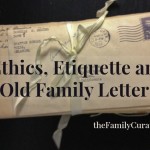This article was written for my local genealogy society newsletter. You are welcome to use it in your own society online or print publication; please credit www.TheFamilyCurator.com.
Genealogists may not see eye to eye on the Perfect Organizational System for data and sources, but they will certainly agree that they would rather spend time finding ancestors than filing papers. The challenge is to create a system that suits the personality and habits of the user and is easy to create and maintain.
Here are four systems worth investigating –
Organize Your Paper Files http://www.fileyourpapers.com/
Genealogical Research Associates recommends using a straightforward numerical system based on Marriage Record Numbers in conjunction with your genealogy database software program. An illustrated tutorial provides step-by-step instructions for setting up and filing papers.
Finally, Get Organized http://blog.dearmyrtle.com/2009/01/finally-get-organized-jan-2009.html
Dear Myrtle (speaker and podcaster Pat Richley) describes her system of 3-ring notebooks in the first monthly installment of the series “Finally, Get Organized: January 2009 Checklist.” The monthly PDF checklists highlight different aspects of genealogy work, from organizing files to time management. Find the organizing blog posts by typing “checklist” in the “Search This Blog” search box.
Organizing Your Files https://wiki.familysearch.org/en/Organizing_Your_Files
Folders, binders, and overall concepts are all discussed in a comprehensive article on the FamilySearch Wiki. Beginning with a discussion of the value of organizing your files, through organizing principles, setting up a system, maintaining your files, and using document numbers for filing, this article lays a good foundation for any genealogy filing system.
How I Organize My Genealogy http://www.youtube.com/watch?v=mrWf6VmKVCs&feature=related
Elyse Doerflinger is a college student and experienced genealogy blogger and speaker. She has recorded a series of YouTube videos featuring step-by-step instructions for setting up a genealogy filing system and staying on top of the paper piles. Browse videos by Elyse90505 for more simple, effective filing tips.
If you haven’t found The Perfect System yet, don’t despair; keep looking and asking questions. And, as you investigate all the many possibilities, use a simple system that helps you stay in control of your research so you can spend your time finding – instead of filing – your ancestors.
Ten Tips for Organizing Genealogy Research
- Sheet Control – Use standard 8 ½ x 11-inch paper for all notes and printouts.
- Stay Single – One surname, one locality per sheet for easy filing.
- No Repeats – Avoid errors; write legibly the first time.
- Dating Yourself – Always write the current date on your research notes.
- Be Color Clever – Distinguish family lines with different colored folders, binders, tabs.
- File First – File one research trip or effort before starting the next one.
- Ask Directions – Write your own filing instructions; a big help when you take a long break.
- Supply Closet – Keep a stash of folders, plastic sleeves, tabs, printer ink.
- One File at a Time – Work through paper piles steadily; the mess didn’t happen in one day.
- KISS – Keep It Simple, Silly! Use an easy to set up, easy to maintain system.









Hi
Thank you for your many helpful suggestions.
I am a BIG fan of color coding things (I’d color code my kids if I could) LOL
I like many of the different suggestions but I am still not quite sure I understand a solution for numbering non-direct line family members and naming of the digital files.
Example:
I understand –
My number would be 1. My siblings would be 1a, 1b… My Father would be 2. His siblings 2a, 2b… My Mother would be 3. Her siblings would be 3a, 3b…
But –
How do you number people that are not in your direct line? My brother or sister -in-laws? Their parents? My aunt and uncles spouses? My cousin’s spouses? Step mother? Half siblings? Step siblings?
Also I have a question about storing the data file and the documents and naming/numbering them.
I understand the I can make an alias of the original files and put them in each individual’s folder. Should I change the title (name and/or number) of the alias to reflect the folder it is currently in?
I prefer the When/What/Who/Where system. But I also am interested in finding out more regarding a numbering system and possibly using it for the original documents.
And how to title photos?
Thank you for your help
Kim
Hi Kim – Color coding is helpful, but I use it sparingly. Otherwise, I tend to get bogged down in the details of “organizing” and lose my precious research time.
To answer your question about numbering: I use surnames, not numbers, but if you prefer numbers, you might want to try using the Record Identification Number assigned by your genealogy software. This will be a unique number for each individual in the database. Of course, using files for individuals will grow quickly. I find it easier to set up files for couples or family groups. You’ll find several different options for setting up a file system in my book How to Archive Family Keepsakes. If you choose to use numbers, you might want to set up an index as well to make it easier to find individuals. You could use the same numbers as part of your digital filename for documents and photos as a cross-reference between original and digital file.
Great resources! Organizing is on every genealogist's mind. I tried every method I could find over the past 15 years but I outgrew each of them. I finally created a source based method to organize my research and now it's a breeze to find documents and to quickly file away the new ones that arrive. I wrote about it on my blog a few months back and it's been getting a lot of great feedback: http://geneartistry.com/organizing-your-documents .
Thanks for this blog post. I've benefited from Elyse's videos too, but I didn't know that Dear Myrtle had a section on it. I will check that out. I stumbled across your webpage because I'm trying to put together a page of video resources that I've found helpful for organizing genealogy research. Maybe some of those resources could be helpful to you too.
The easiest filing system I have ever seen is one recommended with the early versions of the Personal Ancestral File program (PAF). It even came with a program to support it, the Research Data Filer.
The simplest solution is this: number each document with a serial number, and file them in numerical order. Use a computer program to keep track of the contents of the paper file.
The Research Data Filer had (has — i still use it!) two files – documents and data. The document file contains a description of each document. The data file indexes the people in the documents, and allows you to enter the kind of information contained in the documents – the fields are: Document Number, Page, Name, Sex, Id, Event, Date, Place, Rela(ations), Relations IF numbers (up to 3) and Comments. For Id I use the RINs allocated by my generalogy program, since they are unique to each person.
Thus is you are looking for a person, you can earch on name or Id, and it comes up with a liast of the documents that contain information on that person, which you can then find easily, because you’ve filed them in numerical order.